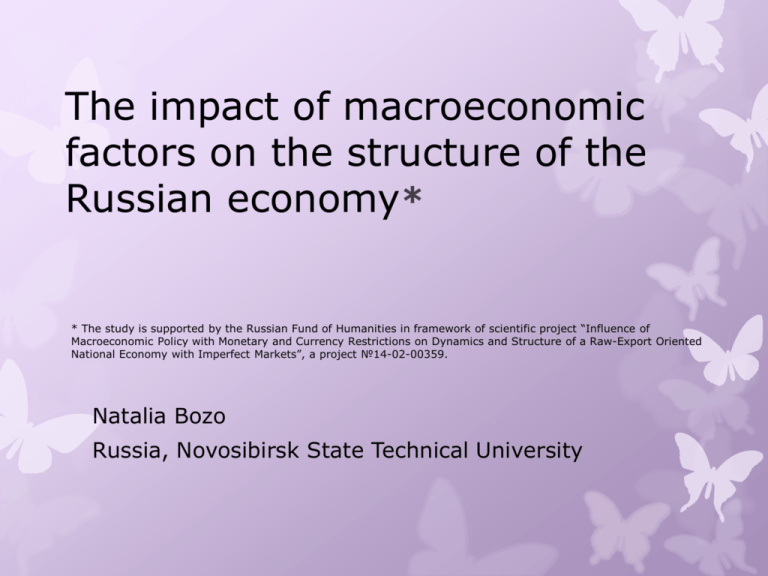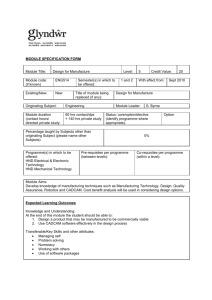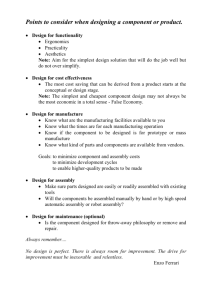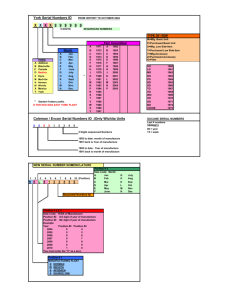The impact of macroeconomic factors on branch structure of
advertisement

The impact of macroeconomic factors on the structure of the Russian economy* * The study is supported by the Russian Fund of Humanities in framework of scientific project “Influence of Macroeconomic Policy with Monetary and Currency Restrictions on Dynamics and Structure of a Raw-Export Oriented National Economy with Imperfect Markets”, a project №14-02-00359. Natalia Bozo Russia, Novosibirsk State Technical University A problem under consideration within the project is: Extension of the macroeconometric GE IO model of the Russian Economy with supply side The key issues for this study are: 1. Changes in factor’s productivity of the main sectors of the Russian Economy in 2003-2013. 2. Estimation of impact of the supply’s factors on production in the main sectors in the shortterm and middle-term periods for the Russian Economy in 2003-2013. Table 1. The dynamic of the labor productivity of the main sectors of the Russian economy in 2003-2013 Labor productivity by gross output, Type of economic activity $/employed 2003 year 2013 year 5365 Agriculture and Forestry 21181 Fishing 30205 50880 Electricity, gas and water supply 20459 91647 Construction 10454 51078 Trade and Services 11222 44687 Transport and Communications 13911 59985 Finances 23199 102136 Investments 12793 58311 Science and Information Technology 2451 12642 Public Health Services, arts, culture and other 4591 24162 social services Other community, social and personal services 5772 20962 Mining and quarrying 47176 273403 Manufacturing 17207 92800 Hotels and restaurants 4940 30032 Public administration and defense; social 13730 60958 insurance 3 Labor productivity by VA, $/employed 2003 year 2013 year 2790 10498 16691 23892 7140 31444 5030 23148 8013 26749 7790 28250 16401 72380 8362 38074 1701 9552 2741 14801 3099 22561 5183 2660 6499 11644 180775 26303 14640 32336 Table 2. Growth rates of the labor productivity and capital productivity of the main sectors of the Russian economy, in 2013 to 2003 Growth rate Capital productivity Labor productivity Agriculture and Forestry 1,628 1,318 Fishing 0,935 1,133 Electricity, gas and water supply 1,050 0,803 Construction 1,496 1,521 Trade and Services 1,635 1,027 Transport and Communications 1,585 1,176 Finances 2,093 1,624 Investments 1,598 1,614 Science and Information Technology 1,057 0,76 Public Health Services, arts, culture and other social 1,113 0,777 services Other community, social and personal services 1,021 0,757 Mining and quarrying 1,207 0,698 Manufacturing 1,650 0,858 Hotels and restaurants 1,627 1,324 Public administration and defense; social insurance 1,031 0,668 Type of economic activity 4 Fixed assets index Fig. 1. The dependence of the Russian sectors’ output on the employment and fixed assets indexes (2013 to 2003). 2.200 Finances 2.000 Trade and Services 1.800 Mining and quarrying Public administration… Manufacturing 1.600 Other community, social and personal services Public Health Services,… 1.400 Transport… Science and Information Technology 1.200 Hotels and restaurants Electricity,… Agriculture and Forestry Construction Investments 1.000 0.800 0.600 5 Fishing 0.800 1.000 1.200 1.400 1.600 1.800 Employment index Fig. 2. The dependence of the Russian sectors’ output on the labor productivity an capital productivity indexes (2013 to 2003) 6 Table 3. The dynamic of the labor productivity for sub-sectors of manufacturing of the Russian economy The detalization of manufacturing sector manufacture of food products, including beverages, and tobacco manufacture of textiles and textile products manufacture of leather, leather products and footwear manufacture of wood and wood products manufacture of pulp, paper and paper products; publishing and printing manufacture of chemical products manufacture of rubber and plastics products manufacture of other non-metallic mineral products manufacture of basic metals and fabricated metal products manufacture of electrical, electronic and optical equipment manufacture of transport equipment other manufacturing 7 Labor productivity by gross output, $/employed 2003 year 2013 year 26578,0 7463,7 8437,8 12079,1 25013,1 24775,1 20497,6 13265,6 32786,7 9186,9 15555,6 46003,9 80751,7 14488,1 26025,7 27851,0 59068,0 141935,2 78048,4 63241,1 119548,7 59663,9 82490,4 83054,0 Labor productivity index Fig. 3. The correlation of share expenses on the technological innovation in volume of sales and the labor productivity and capital productivity indexes. (detailed by manufacturing sector) 3,50 manufacture of rubber and plastics products 3,00 manufacture of electrical, electronic and optical equipment manufacture of chemical products 2,50 manufacture of transport equipment manufacture of basic metals and fabricated metal products 2,00 manufacture of leather, leather products and footwear manufacture of other nonmetallic mineral products 1,50 manufacture of pulp, manufacture of food paper and paper products, including products; publishing and beverages, and tobacco manufacture of wood and printing wood products other manufacturing 1,00 0,50 manufacture of textiles and textile products Capital productivity index 0,00 0 0,2 0,4 0,6 0,8 1 1,2 1,4 1,6 1,8 2 Methodological approach includes the 6 following steps: 1. Making a classification of factors affecting the dynamics of industries under consideration. 2. Identification of indicators, corresponding with the factors determined by the previous step. 3. Analysis of the dynamics of production for industries under consideration. 4. Evaluation of the sensitivity of the production volume to the selected factors for each industry under consideration. 9 5. Ranking industries according to the degree of sensitivity of a variety of production volumes to selected factors. Table 5. Factors classification, influencing on basic industries development and economy as a whole (fragment) 10 An impact on the enterprise level A sectoral impact Factors having an impact on supply Factor name Flow of costs Production capacity Degree of utilization of production capacity Rent, electricity Bringing the product to the end consumer Investments Goods and services quality Scale of production Production internalization level Capital internalization level Mobility of labor Recreation services Labor costs Creative potential Technology opportunities - innovative activity - science and technology development level Character of techniques in operation Flow of costs cation Government support level (targeted) Expectations of manufacturers Inventory level Production capacity Production capacity (загруженность) Degree of utilization of production capacity (backlogs) Labor accessibility Bringing the product to the end consumer Investments Short-term period + + + + + + + + ++ + + + + + + MediumLong-term term period period ++ + + + + ++ + + + ++ + + + ++ ++ (+) + + + + + + + +-+ + + + + + (+) + Model 1. The impact of the short-term and the medium term factors on the current economic capacity 11 Table 6. Assessment results of the impact of the mediumterm factors on the gross output in the short-term of the Russian economy (Model 1) Type of economic activity Agriculture and Forestry Fishing Electricity, gas and water supply Construction Trade and Services Transport and Communications Finances Investments Science and Information Technology Public Health Services, arts, culture and other social services Other community, social and personal services Mining and quarrying Manufacturing Hotels and restaurants Public administration and defense; social insurance 12 Сonstant 0,018 Salaries 0,989 (0,260) Value added -0,004 0,008 -0,720 -2,133 1,096 (0,175) 0,465 (0,154) -0,613 0,055 0,043 2,206 (0,491) 4,403 (1,246) 1,590 (0,735) -0,138 (0,220) 1,829 (0,518) 0,003 2,689 (1,407) -1,263 -0,005 0,150 -1,467 0,046 1,797 (0,243) Employment 0,694 (0,138) 0,691 (0,089) 0,933 (0,125) 1,030 (0,134) 1,181 (0,194) 1,492 (0,274) 1,270 (0,181) 1,040 (0,438) 0,512 (0,177) 0,464 (0,127) 1,612 (0,310) 0,863 (0,204) 1,114 (0,099) 1,465 (0,140) Fixed assets Profitability R2 0,493 0,639 0,620 0,845 0,749 0,575 0,601 0,286 0,197 0,332 0,443 -2,713 (0,844) 0,428 -5,283 (0,722) 0,915 0,786 Model 2. The impact of the medium-term factors on the dynamics of production in short-term I - technological innovations, 𝛽𝛽 𝛾𝛾 𝑌𝑌𝑡𝑡 = 𝐿𝐿𝛼𝛼𝑡𝑡−1 𝐾𝐾𝑡𝑡−1 𝐼𝐼𝑡𝑡−1 𝑙𝑙𝑙𝑙𝑌𝑌𝑡𝑡 = 𝛼𝛼𝛼𝛼𝛼𝛼𝐿𝐿𝑡𝑡−1 + 𝛽𝛽𝛽𝛽𝛽𝛽𝐾𝐾𝑡𝑡−1 + 𝛾𝛾𝛾𝛾𝛾𝛾𝐼𝐼𝑡𝑡−1 13 (2.1) (2.2) Table 7. Assessment results of the impact of mediumterm factors on the gross output in the Medium-term of Russian economy (Model 2) Type of economic activity Сonstant Agriculture and Forestry 0,054 Fishing Electricity, gas and water supply -0,215 Construction 0,310 Trade and Services 0,047 Transport and Communications 0,030 Finances 0,116 Investments Science and Information Technology 0,004 Public Health Services, arts, culture and other social services Other community, social and personal services Mining and quarrying -0,008 Manufacturing 0,201 Hotels and restaurants 0,144 Public administration and defense; social insurance 14 0,060 0,059 0,052 Fixed assets 3,454 (0,669) Accumulated technological knowledge Employ ment R2 0,51 0,811 (0,298) -11,446 (3,210) 4,637 (1,538) 3,476 (0,495) 0,978 4,037 (0,132) (0,656) 2,141 (0,166) multicollinearity is close to 1 0,751 (0,134) 0,273 1,867 (0,050) (0,347) -0,427 3,271 (0,141) (0,764) 0,287 (0,053) 0,813 2,613 (0,167) (0,548) 1,052 1,759 (0,207) (0,331) 0,325 -0,580 (0,024) (0,084) 0,34 0,26 0,66 0,76 0,86 0,546 0,680 0,566 0,533 0,501 0,694 0,893 Multiplicative effect of the medium-term factors and the impact of integrated medium-term factor made it possible to get following analysis. 15 Table 8. Assessment of the multiplicative effect impact of the medium-term and integrated factors on the physical volume of gross output for the Russian economy Type of economic activity Agriculture and Forestry Fishing Electricity, gas and water supply Construction Trade and Services Transport and Communications Finances Investments Science and Information Technology Public Health Services, arts, culture and other social services Other community, social and personal services Mining and quarrying Manufacturing Hotels and restaurants Public administration and defense; social insurance 16 Multiplicative effect of medium-term factors (𝛿𝛿) Integrated factor (𝛽𝛽) -1,442 0,503 -0,119 1,590 0,513 0,987 0,717 1,475 -0,209 2,014 -0,071 0,350 -1,268 0,472 0,699 0,830 -3,388 0,062 0,284 0,235 -0,412 0,342 0,749 1,256 -0,536 0,275 0,382 0,560 0,170 0,091 Table 9. The Comparison of the results of the demand and supply factors on economic industries 2 Type of economic activity Agriculture and Forestry Fishing Mining and quarrying Manufacturing Electricity, gas and water supply Construction Trade and Services Transport and Communications Finances Investments Science and Information Technology Public Health Services, arts, culture and other social services Other community, social and personal services 17 2 R of the results which were obtained by demand factors 0,20 0,20 0,17 0,61 0,49 0,61 0,92 0,53 0,86 0,62 0,76 R of the results which were obtained by supply factors 0,41 0,332 0,78 0,443 0,493 0,639 0,428 0,915 0,620 0,845 0,749 0,575 0,601 0,286 0,197 Conclusion The Medium-term (supply side) factors have a greater impact on: Agriculture and Forestry Fishing Mining and quarrying Manufacturing Electricity, gas and water supply Construction The short-term factors (demand side) have a significant impact on: Trade and Services Finances Investments Science and Information Technology Other community, social and personal services Both (supply factors and demand factors) have equal impact on: Transport and Communications Public Health Services, arts, culture and other social services 18 Thank you for your attention!








